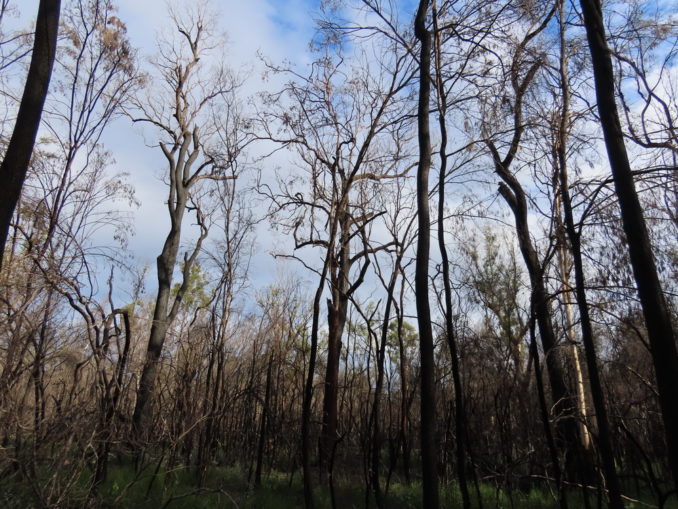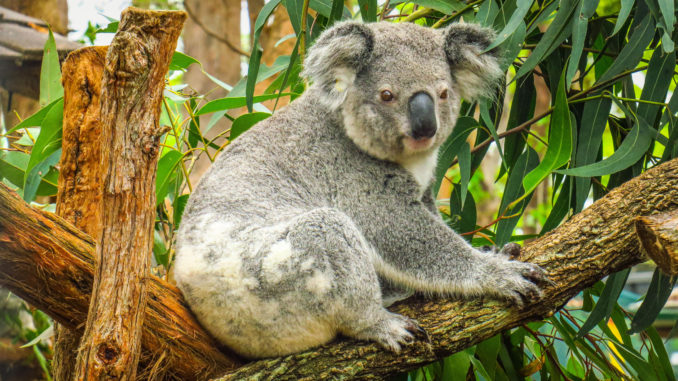The impacts of bushfires, land clearing and forest logging were key concerns during the NSW Upper House Inquiry into Koala Populations and Habitat, writes Marco Stojanovik.
Rows of empty trees stretched far into the distance, branches stripped of leaves, barks singed black. Almost three months after fire swept through the forests of the Banyabba Area of Regional Koala Significance (ARKS) last October there was still no regrowth.
“It was a pretty horrible landscape,” spokesman for North East Forest Alliance (NEFA), Mr. Dailan Pugh said.
“Even where half the trees survived the ground was black and hot, filled with ash.”
The Banyabba ARKS takes in the Bungawalbin, Doubleduke and Myrtle state forests in North East NSW. It consists of 71,000 hectares of likely koala habitat, 83 percent of which was burnt in the fire.
“The rule holds in the heavily burnt areas koalas were likely killed.” Mr. Pugh said.
The number of koalas that survived the fire in the partially burnt areas went on declining during the ongoing drought. By the time rain finally arrived in late December and forests slowly began to recover, for many koalas it was too late.
The impact of last season’s bushfires has been a major concern expressed by many during the recent NSW Upper House inquiry into Koala Populations and Habitat.
“There are really only a few areas now of significantly unburnt blocks of koala habitat,” Hotspots Ecologist at the Nature Conservation Council (NCC), Mr. Mark Graham told a hearing in December.
“Without any doubt there will be ongoing declines in koala populations from this point forward, given the massive swathes of the landscape burnt, the lack of refuges and the ongoing drought.”

Already an estimated two-thirds of the koala population in NSW has been lost over the last three generations due to drought, bushfires, and man-made causes, according to a scientific study conducted by the International Fund for Animal Welfare released in March. The study estimates 6,382 koalas – 15% of the NSW population – were killed across the state last bushfire season.
Resources and planning need to be in place to deal with the bushfire threat, the Planning and Environment Committee heard at multiple hearings throughout the inquiry.
A re-evaluation of how fire is managed is “essential” to “give our wildlife a future,” Mr. Pugh said at a hearing in February.
“Our National Parks and Wildlife Service [are] basically tasked with protecting property… I fully appreciate the emphasis on saving people’s homes… but we need people tasked with protecting our environment.”
Similar concerns were expressed about the lack of protections against excessive land clearing.
“I strongly believe the best thing we can do for koalas is stop clearing their habitat through strong laws that are formed using detailed knowledge of koala ecology and biology,” Koala Ecologist and the President of Koala Recovery Partnership, Dr. Rebecca Montague-Drake said at a hearing in February.
A number of policy decisions in recent years by the Berejiklian government, including the repeal of the Native Vegetation Act in 2016, have loosened the restrictions on land clearing.
Approvals for clearing trees in NSW increased almost 13-times in one year after the Native Vegetation Act was repealed, according to a report by the Natural Resources Commission.
The secret report completed last July was only released in March after a threat of legal action from independent NSW MP Justin Field.
“The management of natural resources under the NSW Nationals have been a catastrophic failure that has led to seemingly unrestrained land clearing approvals,” Mr. Field said in a statement.
Among the areas increasingly approved for clearing have been koala habitats.
Clearing of known or likely habitat in North-Central NSW almost tripled in one year following the repeal of the Native Vegetation Act, according to a report issued by the World Wildlife Fund (WWF) and the NCC. From 2016-17 to 2017-18 the rate of forest and woodland either fully or partly cleared in Moree and Collarenenbri rose from 2,845 hectares to 8,194.
The WWF’s Australian Forest and Woodland Conservation Policy Manager, Mr. Stuart Blanch, told an inquiry hearing in February that now following the fires koalas in NSW warrant “being up-listed… to ‘endangered’ status.”
The WWF has called for stronger protections across land tenures and, along with a number of organisations, a moratorium on logging koala habitats in State forest areas.
On May 15 logging operations began in the unburnt Nambucca state forest. Salvage logging has also been approved by the NSW Environmental Protection Authority (EPA) in 11 burnt state forests, including in the Banyabba region, without first assessing the toll of the fire.
“They’ve got no idea what happened to the koalas and they don’t seem to care,” Mr. Pugh said.
“I find it outrageous that the koala population has been so heavily decimated by the fires… that they could now go in there and potentially cause the extinction of the population.”
Mr. Pugh does not believe the logging protections in place for koalas are adequate.
The current required number of Koala feed trees to be retained are less than half that recommended by the EPA.
The minimum size of feed trees of 20cm in diameter has also been criticized as too small, as have controls to look for 20 scats under a tree to identify koala occupancy.
Mr. Pugh has labelled additional requirements for salvage logging as “tokenism”. Seven per cent of the burnt forest is to be temporarily set aside, as well as the 150 hectares in the Banyabba region that were not burnt out of 5,000.
A spokesman for Forestry Corporation, NSW government’s logging agency, has defended these ongoing operations and additional requirements.
He said that small scale selective timber harvesting is continuing only in areas where scientific assessments have found it “can be appropriately managed within strict conditions”.
“These measures substantially reduce the intensity of harvesting and significantly increase the area of habitat set aside for wildlife,” he said.
Speaking on protections for koalas at an inquiry hearing in February, Forestry Corporation’s Senior Manager of Planning, Dean Kearney, said he is “comfortable with what we do now”.
“We do believe that there is plenty of evidence—scientific and anecdotal—that forests that produce timber can also have an abundance of koalas.”
According to Forestry Corporation, in every area harvested, on average around 40 per cent of that area is set aside for conservation and another 5 per cent of trees are retained as clumps scattered throughout the area harvested. Operations are moved around and all harvested areas are completely regenerated after harvesting.
“That all adds up to a landscape that has quite a lot of useful habitat for a koala,” Mr. Kearney said.


